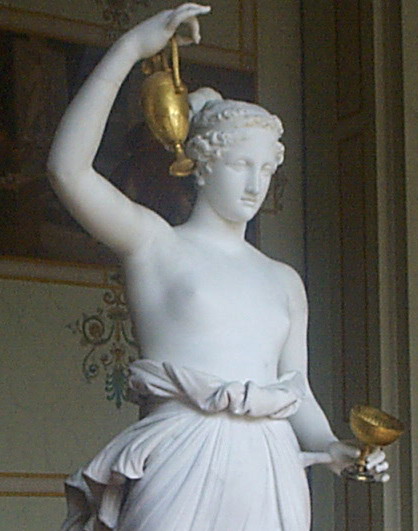return to Home Page
or move on to Goddess Jezanna, next chronologically,
or use Her Cyclopedia Index
Juventas, Youthfulness.
JWV]T1S
Alternate meaning: Youth.
[to Whom the seventeenth day of February, day 047, is dedicated]

Geography/Culture: Roman.
Linguistic Note: From Latin Iuvenis. The names of the Roman Goddesses Juventas, Juno, and Juturna, are all spelt with a J and pronounced with that sound (fopho J as in jaw) even though it is well known that the Roman's did not recognise or use this sound.
Description: Goddess of increase, blessings and youth; She Who represents the eternal youth of the species and its solidarity; She Who has the power to renew the youth of the aged.
Originally, it has been said, the Capitoline triad was composed of
Virgin Juventas, Youthfulness
Mother Juno [Shining-One]
and
Wise Crone Minerva, {Mindful-One}
*
Juventas was later replaced by the male Jove, Youth.
Titles/Variants, etc:
- Variant, and more accurate representation of Her name
Iuventas, YWV]T1S.
- As Hebe, Downy-One, (below), is the maiden form of Hera, so Juventas is probably the maiden form of Juno.
Source: Walker WEMS/481.
Hebe, Downy-One.
H]BA
Alternate meanings: Youth, She-Who-Removes-from-Sight, Virgin-Mother-Earth.
Geography/Culture: Greek.
Linguistic Note: Greek roughbreath-eta-beta-eta, youthful strength, vigour; metaphorically, youthful cheerfulness, or youthful passion, fire, spirit. Related English words: hebephrenia, hebephrenic. Perhaps hebetude, if the Romans took their hebes, hebet-, dull, from the Greek youth.
Description: Goddess of spring and the fresh young shoots of vegetal growth; the unfolding bud; She Who represents the moment of transition between youth and maturity; Cup-bearer to the Deities; Renewer of immortal youth; Harnesser of Hera's horses; Protectress of childhood and virginity.
<<<>>>
Maiden aspect of Triple Hera, Our-Lady,
with
Mother Teleia, Perfect-One
and
Crone Theria, Old-Woman.
<<<>>>
Iconography: Hebe.
To Whom Sacred: ivy; eagle; ambrosia; nectar.
Festival: Kissotomoi, The days of ivy-cutting.
Male Associates: consort, Heracles; sons, Alexiares and Anicetus.
Titles/Variants, etc:
- In the sense of the blossoming of youth She is also called Antheia, Flowery-one.
- She is also called Dia, Of-the-Day, Who is linked with Dione.
- Her name may be etymologically related to Eve, Mother-of-all-Living.
- She is known also as
Ganymeda, Rejoicing-in-virility.
- One of Her companions is Harmonia, Concord-of-sounds, Who is linked with Concordia, Synthesis-of-Minds.
- Perhaps She originated as Anatolian Hepat, Earth-Mother.
- She is the Daughter of Hera, Our-Lady. The terms Mother and Daughter with reference to Goddesses, often mean older or younger aspects of the same concept.
- She was called Juventas, Youthfulness, by the Romans.
- As the first person of the Triple Hera in Arcadia, She is called
Pais, Child'.
- She is also called Parthenia, Maiden, below.
Source: EB Hebe; Graves GMv1 203; IGEL/347.
Parthenos, Virgin-Goddess.
P*3]N0S
Alternate meanings: Maiden.
Geography/Culture: Greek.
Titles/Variants, etc:
- Hebe's alternate name of
Parthenia, Maiden, appears to be a variant of Parthenos.
- The Maiden aspect of Hera, Our-Lady, in the Stymphalus Triad is called Parthenos.
- Sometimes a surname of Athene, I-Have-Come-From-Myself, (Athene-Parthenos),
worked on: December, June 1995; August 1991.
Return to the top of this document.
